Astronomers discovered an amazing phenomenon, two galaxies colliding resemble a pair of eyelids.
Astronomers using the Atacama Large Millimeter/submillimeter Array (ALMA) have discovered a tsunami of stars and gas that is crashing midway through the disk of a spiral galaxy known as IC 2163. This colossal wave of material – which was triggered when IC 2163 recently sideswiped another spiral galaxy dubbed NGC 2207 – produced dazzling arcs of intense star formation that resemble a pair of eyelids.
Above, Credit: M. Kaufman; B. Saxton (NRAO/AUI/NSF); ALMA (ESO/NAOJ/NRAO); NASA/ESA Hubble Space Telescope
Michele Kaufman, an astronomer formerly with The Ohio State University in Columbus and lead author on a paper published in the Astrophysical Journal, said:
“Although galaxy collisions of this type are not uncommon, only a few galaxies with eye-like, or ocular, structures are known to exist.
Galactic eyelids last only a few tens of millions of years, which is incredibly brief in the lifespan of a galaxy. Finding one in such a newly formed state gives us an exceptional opportunity to study what happens when one galaxy grazes another.”
The interacting pair of galaxies resides approximately 114 million light-years from Earth in the direction of the constellation Canis Major. These galaxies brushed past each other – scraping the edges of their outer spiral arms – in what is likely the first encounter of an eventual merger.
Using ALMA’s remarkable sensitivity and resolution, the astronomers made the most detailed measurements ever of the motion of carbon monoxide gas in the galaxy’s narrow eyelid features. Carbon monoxide is a tracer of molecular gas, which is the fuel for star formation.
“Not only do we find a rapid deceleration of the gas as it moves from the outer to the inner edge of the eyelids, but we also measure that the more rapidly it decelerates, the denser the molecular gas becomes,” said Kaufman. “This direct measurement of compression shows how the encounter between the two galaxies drives gas to pile up, spawn new star clusters and form these dazzling eyelid features.”
source public.nrao






Leave A Comment